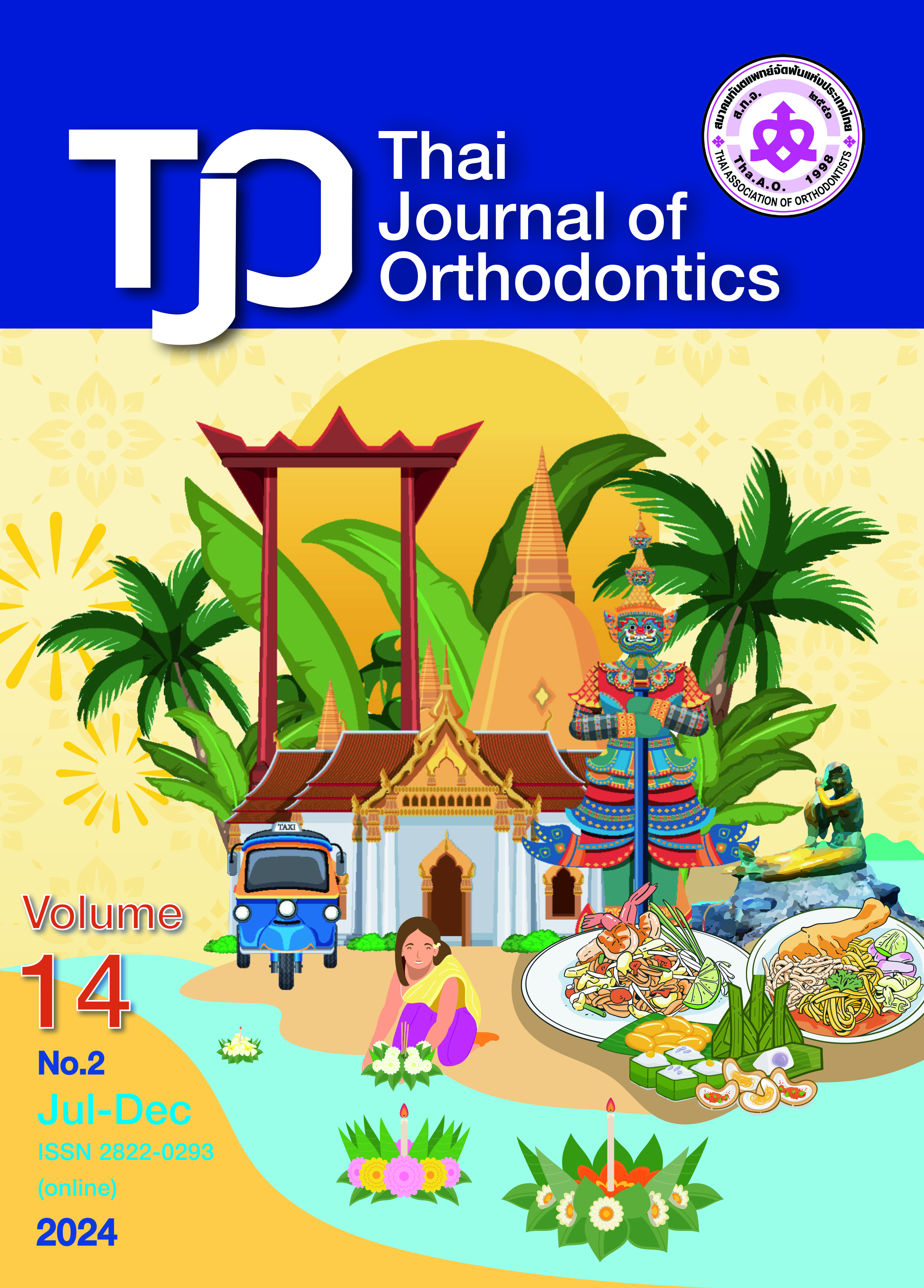Comparison of Masticatory Muscle Effort when Chewing on an Anterior Bite Plane Fabricated from Hard and Soft Materials
Main Article Content
Abstract
Background: Different anterior bite plane materials may affect masticatory muscle effort (ME) differently. ME is defined in this study as the electrical activity used per unit of bite force. Objective: We aimed to compare the effects of a hard acrylic resin anterior bite plane (HARD) and a semi-soft thermoplastic anterior bite plane (SOFT) on ME over a 3-month period in children with deep bites. Materials and methods: Thirty-eight children with deep bites were randomly assigned to either the HARD or SOFT group (n = 19 each). Masseter and anterior temporalis activity along with maximum bite force (MBF) were measured during appliance placement. Anterior and posterior ME were calculated by dividing muscle activity by the anterior and posterior MBF, respectively. Data were collected at baseline (T0), at one month (T1), and at three months (T2). Within- and between-group comparisons were performed (α = 0.05). Results: Neither significant intra-group nor between-group of ME was found throughout the study period (P > 0.05). Conclusion: Neither a hard nor soft anterior bite plane had a disadvantageous effect on ME as none of the ME values exceeded the baseline values during treatment.
Article Details

This work is licensed under a Creative Commons Attribution-NonCommercial-NoDerivatives 4.0 International License.
References
Wasinwasukul P, Nalamliang N, Pairatchawan N, Thongudomporn U. Effects of anterior bite planes fabricated from acrylic resin and thermoplastic material on masticatory muscle responses and maximum bite force in children with a deep bite: a 6‐month randomised controlled trial. J Oral Rehabil 2022;49(10):980-92.
Withayanukonkij W, Leethanakul C, Tangpothitham S. The Change of occlusal bite force during clear aligner treatment and squeezing exercise. Thai J Orthod 2024;14(1):21-30.
Celakil D, Ozdemir F, Eraydin F, Celakil T. Effect of orthognathic surgery on masticatory performance and muscle activity in skeletal Class III patients. Cranio 2018;36(3):174-80.
Koc D, Dogan A, Bek B, Yucel M. Effects of increasing the jaw opening on the maximum bite force and electromyographic activities of jaw muscles. J Oral Sci 2012;7(1):14-9.
Kara B, Yilmaz B. Occlusal contact area changes with different retention protocols: 1-year follow-up. Am J Orthod Dentofacial Orthop 2020;157(4):533-41.
Hazari P. A comparison of masticatory performance and efficiency of complete dentures made with high impact and flexible resins: a pilot study. J Clin Diagn Res 2015;9(6):ZC29-34.
Picinato-Pirola MNC, Mestriner W, Freitas O, Mello-Filho FV, Trawitzki LVV. Masticatory efficiency in class II and class III dentofacial deformities. Int J Oral Maxillofac Surg 2012;41(7):830-4.
Aiyar A, Shimada A, Svensson P. Assessment of masticatory ef f iciency based on glucose concentration in orthodontic patients - a methodological study. J Oral Rehab 2022;49(10):954-60.
Definition of efficiency. In: Collins COBUILD Advanced Learner’s Dictionary. HarperCollins [Internet]. Publishers; 2023. Available form: https://www.collinsdictionary.com/dictionary/english/ efficiency.
Garcia-Morales P. Maximum bite force, muscle efficiency and mechanical advantage in children with vertical growth patterns. Eur J Orthod 2003;25(3):265-72.
Barclay CJ. Efficiency of Skeletal Muscle. Muscle and Exercise Physiology. London, United Kingdom: Academic Press;2019:111-27.
Uchida S, Iwasaki LR, Marx DB, Yotsui Y, Inoue H, Nickel JC. Variations in activities of human jaw muscles depend on tooth-tipping moments. Arch Oral Biol 2008;53(2):199-205.
Dean JS, Throckmorton GS, Ellis E, Sinn DP. A preliminary study of maximum voluntary bite force and jaw muscle efficiency in pre-orthognathic surgery patients. J Oral Maxillofac Surg 1992;50(12):1284-8.
Van Den Braber W, Van Der Glas H, Van Der Bilt A, Bosman F. Masticatory function in retrognathic patients, before and after mandibular advancement surgery. J Oral Maxillofac Surg 2004;62(5):549-54.
Ashok S, Batra P, Sharma K, Raghavan S, Talwar A, Srivastava A, et al. An assessment of masticatory efficiency and occlusal load distribution in adolescent patients undergoing orthodontic treatment with functional jaw orthopedics: a prospective cohort study. J Stomatol Oral Maxillofac Surg 2023;124(6 Suppl 2):101570.
Throckmorton GS, Dean JS. The relationship between jawmuscle mechanical advantage and activity levels during isometric bites in humans. Arch Oral Biol 1994;39(5):429-37.
Faul F, Erdfelder E, Lang AG, Buchner A. G*Power 3: a flexible statistical power analysis program for the social, behavioral, and biomedical sciences. Behav Res Methods 2007;39(2):175-91.
Stegeman D, Hermens H. Standards for suface electromyography: the European project surface EMG for non-invasive assessment of muscles (SENIAM). Hermie J Hermens 2007;108-12
Castroflorio T, Icardi K, Torsello F, Deregibus A, Debernardi C, Bracco P. Reproducibility of surface EMG in the human masseter and anterior temporalis muscle areas. Cranio 2005;23(2):130-7.
Ferrario VF, Sforza C. Coordinated electromyographic activity of the human masseter and temporalis anterior muscles during mastication. Eur J Oral Sci 1996;104(5-6):511-7.
Garcia-Morales P. Maximum bite force, muscle efficiency and mechanical advantage in children with vertical growth patterns. Eur J Orthod 2003;25(3):265-72.
Jakobsen JC, Gluud C, Wetterslev J, Winkel P. When and how should multiple imputation be used for handling missing data in randomised clinical trials - a practical guide with flowcharts. BMC Med Res Methodol 2017;17(1):162.
Zieliński G, Wójcicki M, Baszczowski M, Żyśko A, Litko-Rola M, Szkutnik J, et al. Influence of soft stabilization splint on electromyographic patterns in masticatory and neck muscles in healthy women. J Clin Med 2023;12(6):2318.
Woźniak K, Piątkowska D, Szyszka-Sommerfeld L, Buczkowska- Radlińska J. Impact of functional appliances on muscle activity: a surface electromyography study in children. Med Sci Monit 2015;21:246-53.
Luraschi J, Korgaonkar M, Whittle T, Schimmel M, Müller F, Klineberg I. Neuroplasticity in the adaptation to prosthodontic treatment. J Orofac Pain 2013;27(3):206-16.
Pairatchawan N, Viteporn S, Thongudomporn U. Mandibular incisor root volume changes between anterior bite planes fabricated from acrylic resin and thermoplastic materials: a prospective randomized clinical trial. Angle Orthod 2022;92(6):755-63.


